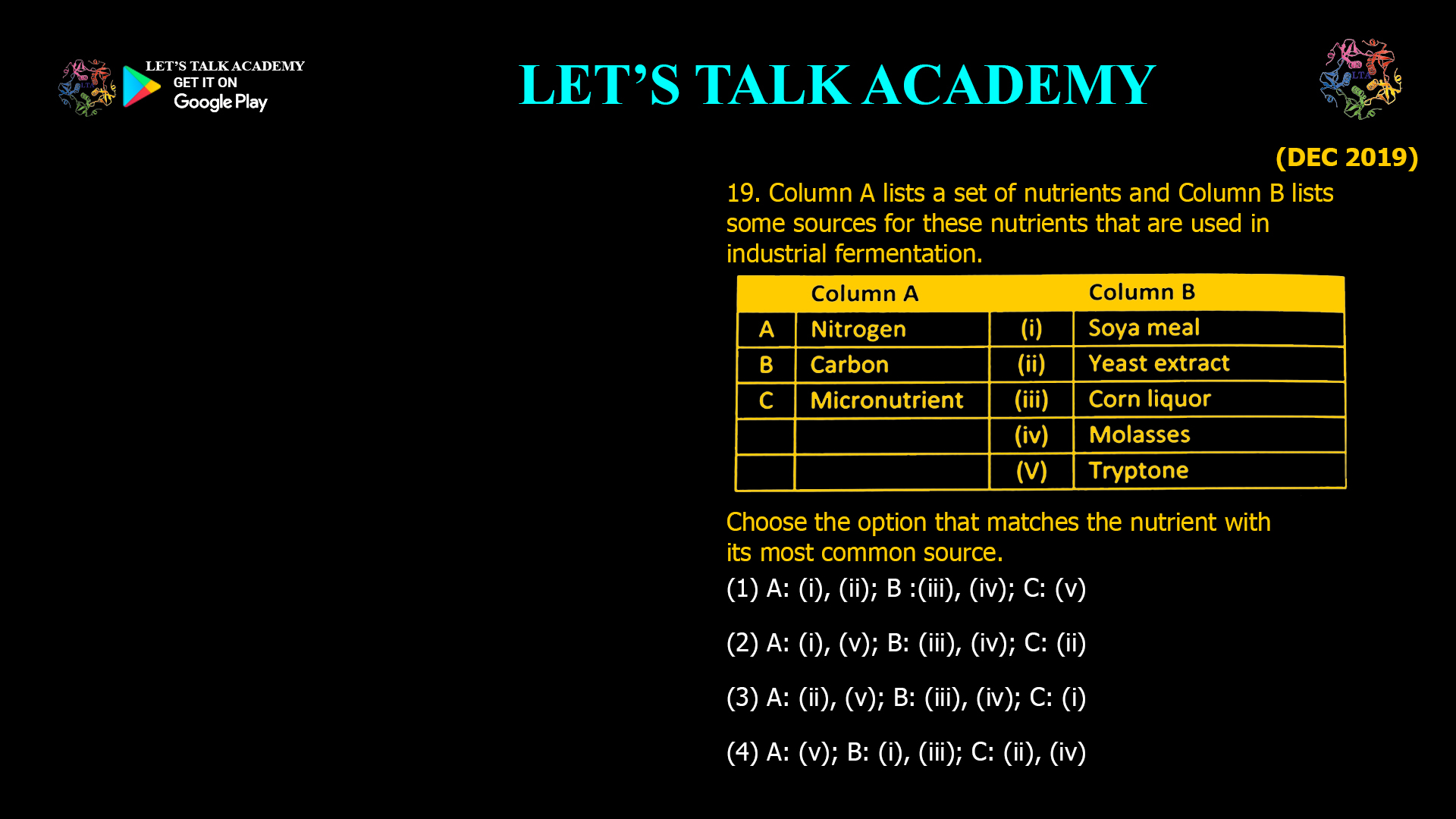- Column A lists a set of nutrients and Column B lists some sources for these nutrients that
are used in industrial fermentation.Choose the option that matches the nutrient with its most common source.
(1) A: (i), (ii); B :(iii), (iv); C: (v)
(2) A: (i), (v); B: (iii), (iv); C: (ii)
(3) A: (ii), (v); B: (iii), (iv); C: (i)
(4) A: (v); B: (i), (iii); C: (ii), (iv)In industrial fermentation media, nitrogen is usually supplied by protein- or amino acid–rich ingredients, carbon comes from cheap carbohydrate by‑products like molasses, and micronutrients are provided by complex supplements such as yeast extract or corn steep liquor. Using this logic, the correct matching in the question is option (4): A–(v), B–(i), C–(ii),(iv).
Question and correct matching
Column A lists:
-
A: Nitrogen
-
B: Carbon
-
C: Micronutrient
Column B lists:
-
(i) Soya meal
-
(ii) Yeast extract
-
(iii) Corn liquor (corn steep liquor)
-
(iv) Molasses
-
(v) Tryptone
Most appropriate uses in typical industrial fermentation media are:
-
Nitrogen source: tryptone, soya meal, corn steep liquor, yeast extract.
-
Carbon source: molasses, corn steep liquor, sugarcane or beet juices.
-
Micronutrient sources: yeast extract and corn steep liquor, which are rich in vitamins, growth factors and minerals in addition to some nitrogen and carbon.
Therefore:
-
A (Nitrogen): best single match among given options is tryptone (v), a casein digest used primarily as an organic nitrogen source in media.
-
B (Carbon): molasses (iv) is a classic cheap bulk carbon source in industrial fermentations.
-
C (Micronutrient): yeast extract (ii) and corn liquor (iii) both serve mainly as complex sources of vitamins and trace elements, so both are correct for micronutrients.
Option (4) gives exactly this pattern: A: (v); B: (iv); C: (ii),(iii). Hence, option (4) is correct.
Why the other options are wrong
-
Option (1): A: (i),(ii); B: (iii),(iv); C: (v)
-
Soya meal (i) and yeast extract (ii) can supply nitrogen, but yeast extract is also a major source of vitamins and growth factors and is more appropriately placed under micronutrients in this matching scheme.
-
Corn liquor (iii) is mainly valued as a nutrient-rich by‑product supplying nitrogen, vitamins and minerals, not a primary carbon source alongside molasses, so pairing (iii) with carbon is less appropriate here.
-
Tryptone (v) is misclassified as a micronutrient, whereas it is used predominantly as an organic nitrogen source in media like LB.
-
-
Option (2): A: (i),(v); B: (iii),(iv); C: (ii)
-
Assigning corn liquor (iii) to carbon again ignores that it is typically used as a complex nitrogen and vitamin source, while carbon still mainly comes from molasses or added sugars.
-
Putting yeast extract (ii) only under micronutrients is partly acceptable, but then nitrogen sources would be limited to soya meal and tryptone, which does not use yeast extract’s well‑known role as a major nitrogen source in fermentation media.
-
-
Option (3): A: (ii),(v); B: (iii),(iv); C: (i)
-
Here, soya meal (i) is placed under micronutrients, even though it is primarily used as a bulk organic nitrogen source, especially after oil extraction.
-
Again, corn liquor (iii) is grouped under carbon instead of recognizing its principal role as a complex nitrogen and vitamin supplement, making this combination less accurate than option (4).
-
SEO‑optimized explanation of each source
-
Tryptone: Enzymatic digest of casein that supplies peptides and amino acids; widely used as an organic nitrogen source in bacterial media such as LB and in many industrial fermentations.
-
Soya meal: Defatted soybean meal rich in proteins, used mainly as a low‑cost organic nitrogen source and sometimes as part of complex media for large‑scale fermentations.
-
Yeast extract: Autolysed yeast providing amino acids, peptides, B‑vitamins and growth factors; functions both as a nitrogen source and an excellent micronutrient supplement.
-
Corn liquor (corn steep liquor): Steep water concentrate from corn wet‑milling, containing amino acids, vitamins and minerals; used as an economical complex nitrogen and micronutrient source.
-
Molasses: Cheap by‑product of sugar industry with 50–60% carbohydrates, widely used as a primary carbon and energy source for yeast and other industrial fermentations.
-



